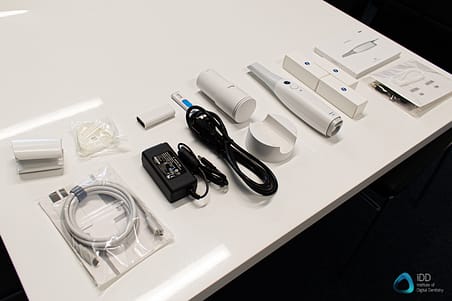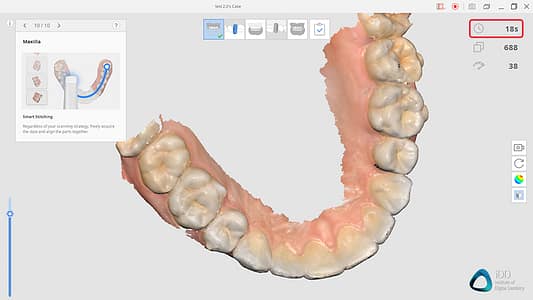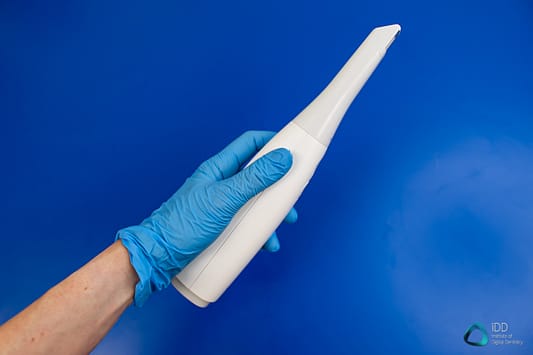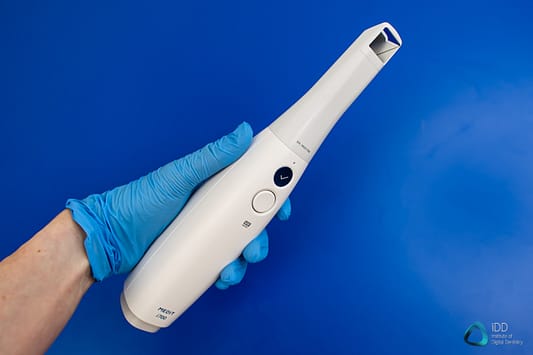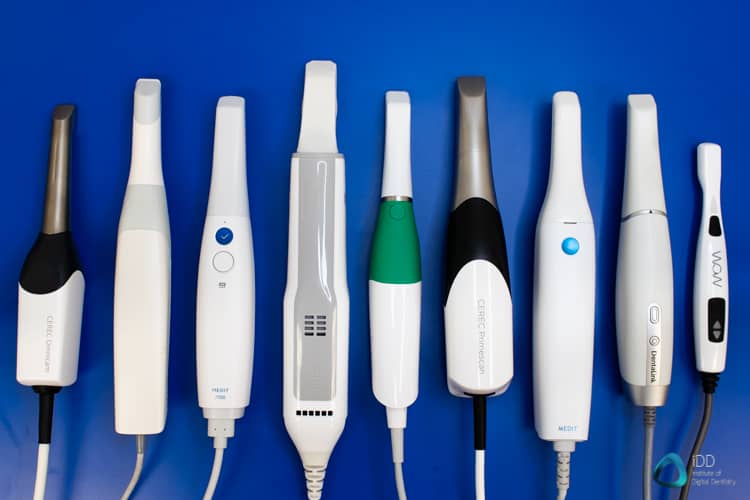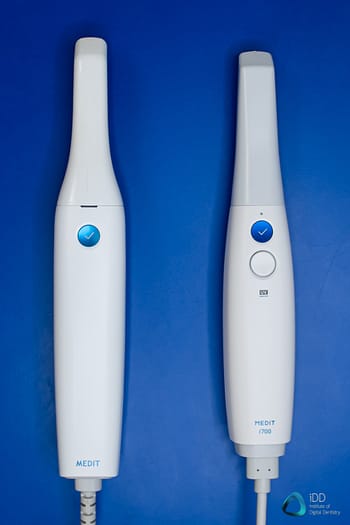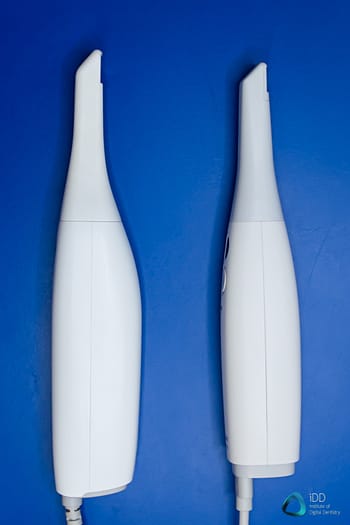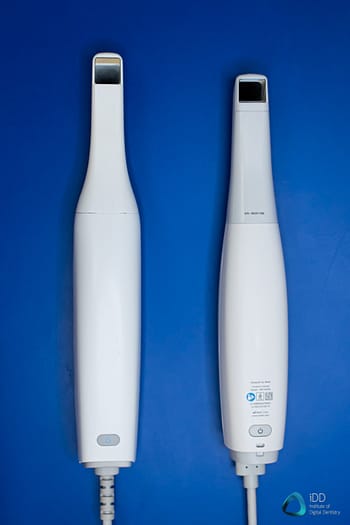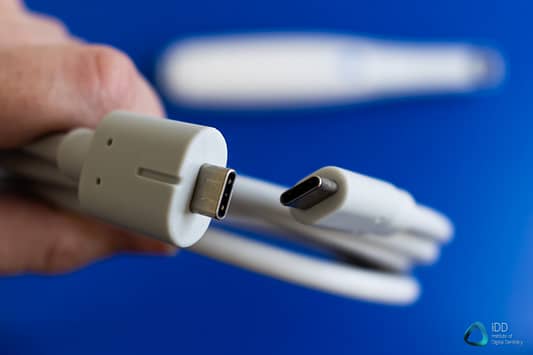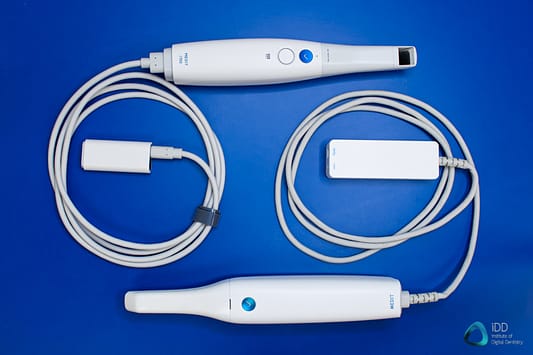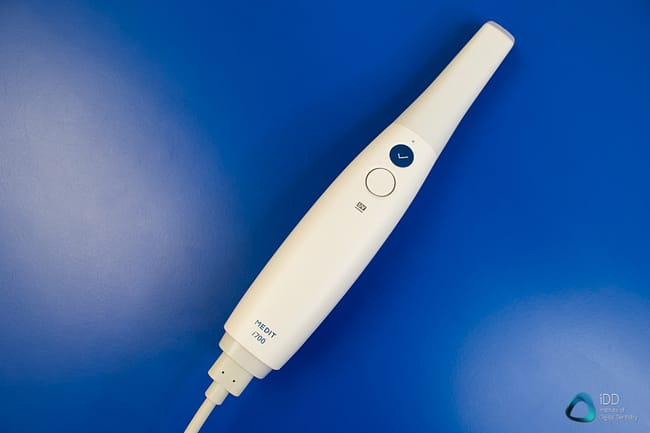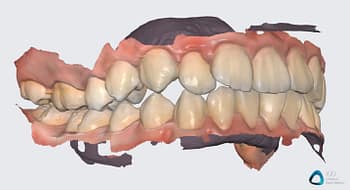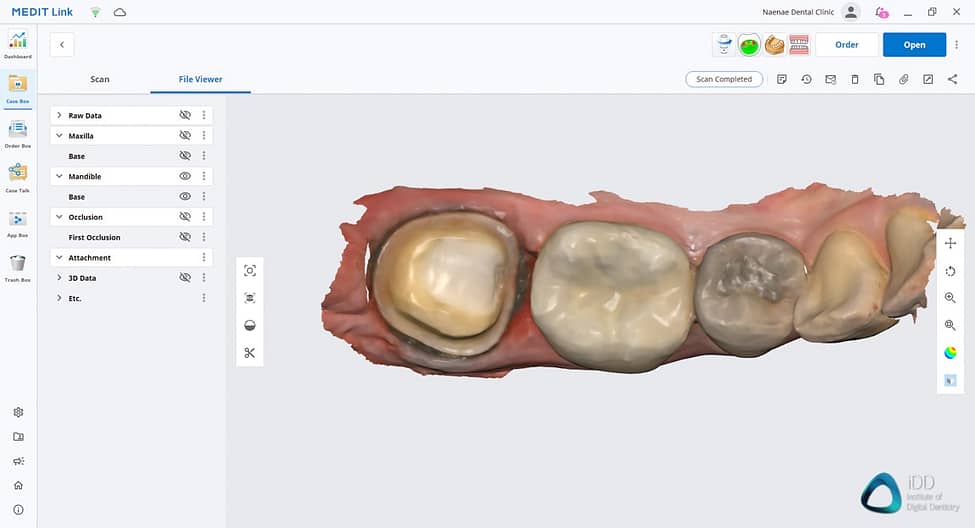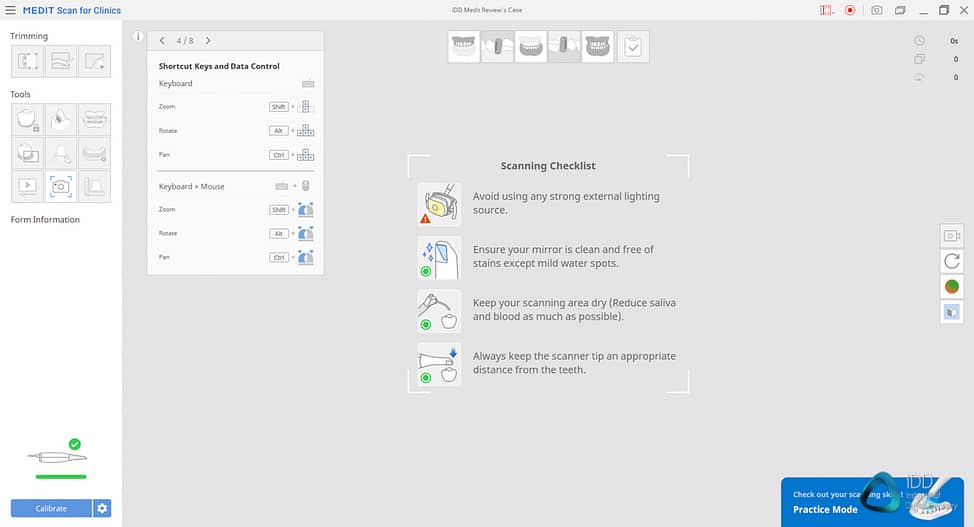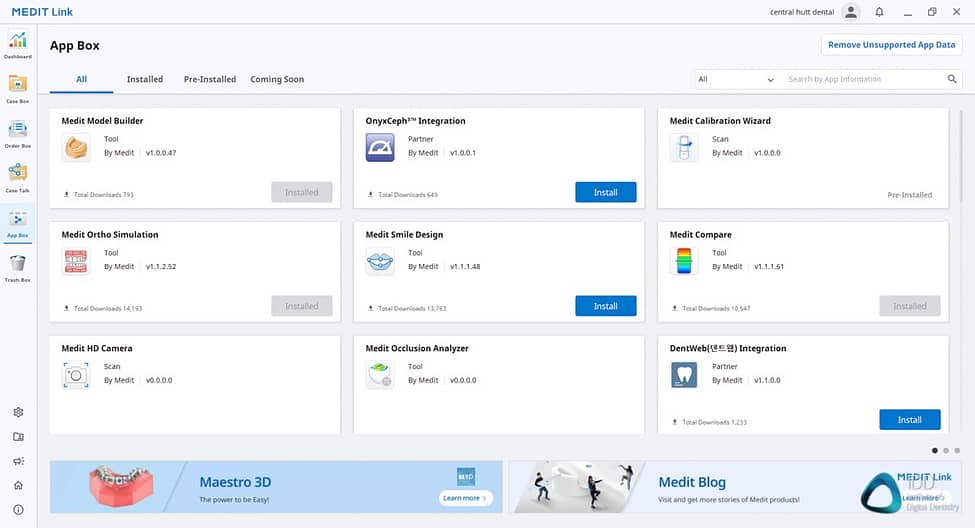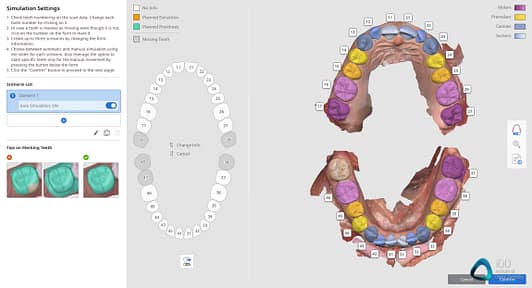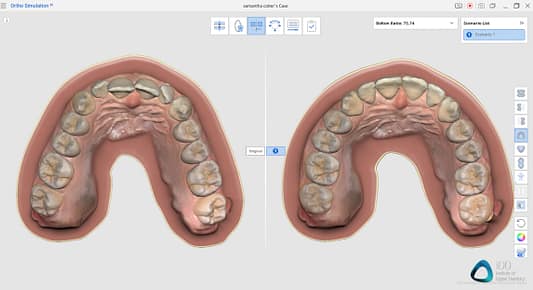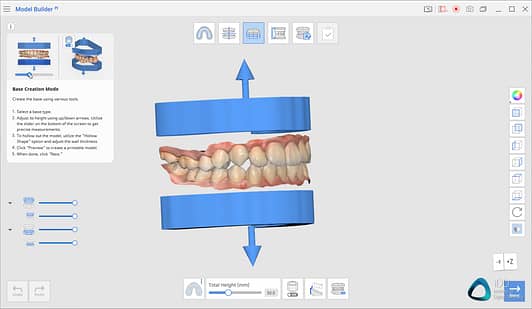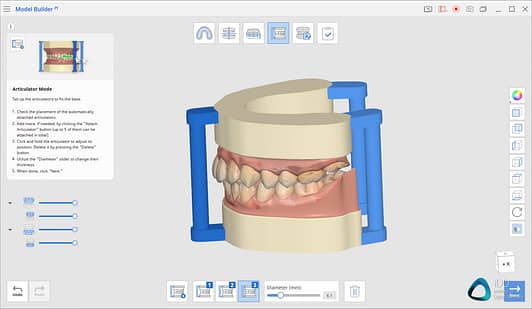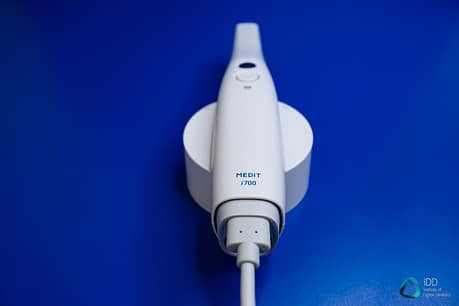The release of the Medit i700 was one of the most anticipated events in digital dentistry this year. Medit released this scanner in April 2021, and the company stayed true to its initial strategy: offer high performance while keeping the price low.
The team at iDD was fortunate to get the first i700 in the entire Asia-Pacific region, and we've been vigorously testing it and learning what it can do ever since. There was plenty to learn, considering the major hardware and software upgrades. The following review goes over our experiences, and we are happy to say that the i700 might be one of the best intraoral scanners now available.
Update:There's now a wireless version of the i700! Check out our article on it here.
Background - the Medit i700
The Medit i700 is one of the newest intraoral scanners released on the market and the second from Medit following the incredible success of their first intraoral scanner, the i500. Initially branding itself as the 'easy entry into digital dentistry', this terminology has changed to 'reimaging scanning'. This is fitting as Medit was primarily seen as a cheap entry point to digital dentistry, but now it is an extremely capable intraoral scanner that performs as well as its competitors but for a fraction of the cost.
For those who don't know, Medit is a Korean digital imaging company that was founded in 2000 as a 3D scanner company for the industrial sector. They have since released several dental products, such as the Medit T-series lab scanners. Their latest product, the i700, is an intraoral scanner released in April 2021. It is the successor to the Medit i500 released in 2018.
Back in 2018, Medit disrupted the entire industry with their low-cost offering, the i500. While many other low-cost scanners struggled to perform and compete with the other major intraoral scanner companies, Medit flourished. This scanner proved to be extremely popular with dentists for its affordable price tag and no subscription fees. With the i700, Medit seems to be doubling down, significantly improving many aspects of the Medit i500 while still maintaining a modest asking price.
The thing that makes Medit stand out compared to other low-cost scanners is the incredible software. Back when we reviewed the Medit i500, this software was in its infancy. Now, it is almost a completely different product. The software that runs the Medit scanners is extremely powerful and provides dental professionals with a vast array of tools that together in one package, are not seen in any other intraoral scanner. The best part? The software is free with Medit only asking for a subscription fee if you opt to use their cloud storage above a 1 GB limit.
When comparing Medit to CEREC, 3Shape, or Planmeca scanners, a crucial distinction is that these systems offer a complete CAD/CAM workflow with associated CAD chairside software. The Medit i700 is just a scanner. It has no Medit CAD software, and on its own, it is only used to scan and export scans. If you are looking to scan and send to labs, this may be exactly what you are after. However, suppose you want to carry out the entire digital workflow in-house, which we recommend to reap all the benefits of digital dentistry, in that case you will need to learn how to use third-party mills and CAD design software such as Exocad.
Here at the Institute of Digital Dentistry, we were fortunate to be the first in New Zealand and the entire Asia-Pacific region to get our hands on the Medit i700 intraoral scanner soon after its release. We have been testing it in the clinic for months. Below you will find our unboxing video and our official review of the Medit i700. These are our findings and thoughts about the Medit i700 and how it compares to the other intraoral scanners on the market.
Disclaimer - no conflict of interest. This is an objective review of the Medit i700. The team at iDD remains unwaveringly committed to providing you with impartial and trustworthy information. Medit had no part in writing this review or restricting any conclusions iDD makes in our thorough analysis and clinical use of these products. Enjoy the review.
Quick Navigation
Review Overview
Scanning Speed
Smart / Segmental Scanning
Inbuilt Fan
Full Arch Scanning
Ease of Use
Open or Closed Architecture
Medit Link
Medit Apps
Medit Compare
Medit Orthodontic Simulation
Medit Smile Design
Medit Model Builder
Medit Crown Fit
Medit Cost
Yearly Fees / Subscription
Review Summary
Review Overview
Evaluation Ratings
Scanning Speed
Scanning Flow
Scanner Size
Ease of Use
Investment Cost
Additional Features
Touch Screen
USB scanner. Can be used with touch screen displays.
Wireless Scanner
Caries Detection
Software Apps
Extensive range including smile design and ortho simulation
CAD/CAM Software
Relies on 3rd Party Software
Subscription Requirements
None. Cloud Storage has a monthly fee after a 1 GB limit.
Autoclavable Tips
100 times per tip
We have added new criteria in our intraoral scanner reviews. This is in response to the fact that most intraoral scanners are now excelling in speed and clinical use. What is differentiating scanners now is software and applications.
Scanning Speed
The i700 is an impressive intraoral scanner, especially for its price. It is blazingly fast and easy to use. Medit recently released a software update (2.4.3) that made it even faster. This is a scanner that easily competes with the more expensive scanners on the market, such as TRIOS, CEREC, and iTero. Using the Medit i700, we can achieve full-arch scans easily under 40 seconds and our fastest full arch scan on a patient was 18 seconds.
The Medit i700 is also faster than the previous generation Medit i500. Those considering which one they should buy should without a doubt go for the newer model. The scanning protocol used with the i700 is similar across all scanners on the market, therefore for us, using it was simple. Scanning across the midline and anterior teeth, traditionally the trickiest areas, didn't take much effort. At first, the scanning image can look grainy and low-quality, but after post-processing, you get the final image. The i700 produces high-definition colour scans that look great.
When using the Medit i700 to take digital impressions, it has a different 'feel' compared to CEREC or TRIOS. One of the main reasons we think this is the case is that the others have a larger scanning field of view. The Medit i700 scanning field of view is 14 x 13 mm. Regardless of this, it is still a high-speed scanner to use.
The AI built into the Medit software is impressive. The scanner is quick to find its place again when the scan is paused and restarted again. Bite scan alignment is also fast. Overall it's a smooth scanning experience with only minor hiccups as we felt it picked up artifacts more than other high-performing scanners such as the CEREC Primescan. The AI, however, makes up for this and effortlessly cleans up the scan. It is fast and very accurate with removing artifacts such as the tongue, cheeks, or gloves that might be picked up. Medit have improved the AI tremendously since the time we reviewed the Medit i500.
What's more, you have many control options built into the software concerning AI sensitivity and even what colors the scanner should ignore. There are many tools built into Medit software that help improve scanning speed and functionality, and we wonder why these are not present in other scanners that cost double the price.
Like all other scanners, interproximal areas typically require a few touch-ups after the main scan is done to catch all the data if needed. The scanner is used without scanning powder (do we even have to mention this anymore?). Additionally, the Medit i700 does not have major issues with scanning metal surfaces. It even has a 'metal scan' mode which makes scanning shiny surfaces even more manageable. Scanning metal involves angling the scanning in different directors to avoid light reflection. Overall, we were impressed with the Medit i700, especially for its price.
The Medit i700 is ergonomic and lightweight. The scanner head can be reversed.
Smart / Segmental Scanning
With the release of the i700, Medit also introduced segmental/smart scanning into their software. This software improvement is available for both i500 and i700 scanners and means that rigid scanning strategies are technically no longer required.
A digital model can be created from completely separate scan segments joined together as long as there are some common scanning elements between them. In other words, instead of following a specific scan path, you can scan the left and right quadrants separately and then join them together with a scan of the anterior aspect. This will undoubtedly make scanning even easier for beginners who may struggle with following specific scanning pathways.
The segmental scanning function works impressively well. It is a testament to, again, the intelligent AI built into the software. The software enables you to keep scanning different parts and quickly stitches up images together as soon as there is some common ground.
One concern we have about this is that it is not clear how segmental scanning affects accuracy. It is wellestablished in the literature that scanning strategy is of key importance for accuracy of intraoral scanners, so this feature may be something that is reserved for indications that are not accuracy demanding, or it may become the market norm. Time (research) will tell.
Scanner Size & Ergonomic Design
The previous generation Medit i500 was and still is one of the smallest and lightest scanners on the market. It boasts a small scanner head and good ergonomics. The i700 is even better in almost every way.
The i700 is smaller and lighter than almost every other scanner on the market. It is 25% smaller and 12% lighter than the previous generation Medit i500. The new i700 is also very lightweight, weighing in at 245 grams. For reference, the i500 is 280 g. Compare this to other scanners such as TRIOS (~345 g), CEREC Primescan (~457 g), Omnicam (315g), and iTero (~500 g). The weight of the i700 makes it very ergonomic and comfortable to use. That is one thing we noticed straight away when holding the i700 for the first time.
The Medit i700 is one of the smallest and lightest intraoral scanners on the market.
From left to right: CEREC Omnicam, TRIOS 3, Medit i700, iTero Element 5D, Planmeca Emerald, CEREC Primescan, Medit i500, Fussen DentalLink, WOW IOS.
The i700 has a simplistic design. Like the i500, the i700 has two buttons, one on the top of the scanner used to start and stop the scanning process and a power button on the bottom to turn the scanner on and off. There is a new additional remote control button beneath the scanning button. This is a new feature for the Medit i700 and is unique to this scanner across the entire market.
The remote control button enables checking and manipulating scan data without touching the keyboard, including switching between scan stages and rotating any digital models. This is an excellent way to improve cross-infection control which is arguably even more critical with laptop-based scanners.
Although it sounds good on paper, it is a function that takes some time to get used to and doesn't quite work perfectly as it can be hard to orientate scans. It's simply a lot easier to just use a mouse/touchpad. Due to the proximity to the scanning button, I also found myself accidentally pressing the remote control button often by mistake when trying to start a scan. This is because I am not used to it as it is a feature not seen anywhere else in the market. I would have liked it more if the remote button was not as close to the scan button.
The Medit i700 (right) is a significant improvement in both aesthetics and ergonomics when compared to the Medit i500 (left). The shape, weight and size of the scanner have all been improved.
Also note the remote control button beneath the scanning button in the Medit i700.
Overall, the scanner is comfortable to hold and ergonomic enough that we didn't have any long-term use issues. The scanner is held in a pen-grip. Some problems we had with the i500 being quite broad and making it a bit uncomfortable are completely resolved with the i700. This scanner feels great in the hands, and it is easy to reach all buttons when holding it. Some excellent quality of life additions have also been added, for example, the scanner head is now fully reversible, meaning it can be rotated 180 degrees and attached to the scanner (similar to TRIOS).
The Medit i700 is plug and play, so you connect it to a suitable laptop/computer by USB and use it. Another unique feature of the Medit i700 is that it no longer requires a power hub, unlike the Medit i500 and all other USB scanners on the market. This only works if your laptop/desktop has a USB C port and enough power to feed the scanner. The fact that Medit managed to run the scanner purely on USB C alone is an incredible feat and is a considerable quality of life improvement. It makes the scanner very convenient to use and move between computers/surgeries as you are not dealing with power cords anymore.
The Medit i700 is the only intraoral scanner that can be used by USB C alone. Cable shown on the left.
The power hub is shown on the right if required. This is much smaller than the Medit i500 (bottom) version
Alternatively, if your laptop cannot power the Medit i700 using USB C alone, you will need to use the included power hub and connect it to a power wall outlet like usual. This is the same as the Medit i500. The only difference is that the power hub included with the i700 has been redesigned and is much smaller.
A common problem with USB scanners is cable management. If you need to use this power hub, there are a few cables you will need to consider when setting it up, and generally, USB scanners are a lot messier than cart scanners. Two main cables come from the scanner, one to the laptop and one to the power hub. With a dedicated cart (many third party options exist now) and cable management this should not be a big deal, however.
Inbuilt Fan
The i700 has an inbuilt fan in the scanner. Like every scanner on the market now, this makes it easy to scan for long periods in the mouth as the fan prevents fogging of the scanner tip. The scanner does take some time to warm up when first starting up, however. We found it takes about 1-2 minutes in which the software advises you to let the scanner warm up before use. The good news is you can bypass this and continue to scan if you are in a rush.
On the internal fan topic, Medit has also added a UV-C Internal LED to the internals of the scanner. This UV-C LED is supposed to aid in the disinfection of the inner parts of the i700. The idea is that fans in intraoral scanners can push contaminated air through the internal part of the scanner, which remains unsterilized (unlike scanner heads which can be autoclaved). Although a great idea, this internal issue has hardly been discussed in the industry before. It is hard to conclude whether this UV-C LED is even required or does what the company says it does. A unique feature nevertheless, and it will be interesting to see if the entire market eventually adds something similar.
The UV-C LED Indicator is shown beneath the remote control button.
How effective this is at disinfection is unconfirmed.
Full Arch Scanning
The i700 is an impressive scanner overall and handles full arch scans well, especially in experienced hands. This scanner can take anything you throw at it - quadrant scans, full-arch scans, edentulous scans, implant scans etc. We could easily carry out full arch scans in under 40 seconds. Its success lies in a combination of factors; fast and accurate scanning, intelligent AI, intuitive software, an inbuilt fan that prevents fogging and enables long periods of uninterrupted scanning.
Using the Medit i700 follows a similar scan protocol identical to almost all other scanners, so this was nothing new for us. The i700 also performs very well when scanning edentulous sites as well.
The Medit i700 handles full arch scanning with ease
Almost every week, we get asked about scanner accuracy. This seems to be a point of contention, and because technology moves at a much faster rate than research, this is indecisive. We will confidently say that the Medit i700 and the i500 are more than accurate for most indications that the majority of users will have - quadrant dentistry/crown and bridge, etc. It is also accurate enough for full arch dentate scans etc. The company claims the Medit i700 can achieve 11 microns full-arch accuracy. For complete arch implant scanning, using photogrammetry is the industry standard rather than just using scanners alone.
Although we do not yet know how the i700 compares in research to all other scanners, we can safely assume it performs just as well as the Medit i500, which has been proven clinically and in research to be accurate enough for all clinical uses.Click here to read an in-vitro studythat compared many intraoral scanners on the market and found the Medit i500 in the top 5.
An example of the Medit i700 UI. You can see all scan files neatly organized on the left.
Ease of Use
As with almost every scanner on the market these days, the i700 does well in making the scanning workflow straightforward for beginners and experienced scanners.
Ease of use comes from the software that supports the hardware. For the Medit intraoral scanners, this is called Medit Link. The Medit workflow is intuitive and follows a simple step-by-step progression, identical across every system on the market. What Medit does very well is, similar to TRIOS, offering several tips and helpful pop-ups during the workflow.
The typical workflow when using the Medit i700 is as follows:
- Filling out the lab sheet and patient details
- Scanning the preparation
- Scanning the opposing teeth
- Scanning the bite
Viewing scans and editing scans can be carried out, and there are many different analysis and scan manipulation tools. This is one part that the Medit software does exceptionally well. The software has an impressive range of various tools. You can also marginate tooth preparations for your lab.
One feature of the Medit i700 that impressed us is the addition of a practice model. This is included in the box and has a QR code that can be scanned with the i700 itself. Once done, this opens up the practice mode, which gamifies the scanning experience with a tutorial mode helping teach new users the scanning protocol - a unique feature to Medit and a really cool addition.
The Medit Link software does not design any prosthetics nor has any design aspects. It is just a scanner and has no CAD design software. For those looking to carry out the entire workflow in-house, this scanner is often bundled with the exocad software. You will need to investigate which third party milling machines you want to use with it if you are looking for an entirely in-house workflow.
The software makes the entire process very easy. There are many on-screen tips, help screens, and animations to guide you through the process and how to use the various tools.
Overall the software user interface is excellent and works well. Since the days we reviewed the Medit i500 back in 2019, this software has seen constant updates with new tools and features, all free of charge. Medit has impressed us and, without a doubt, their entire customer base with the level of support and improvements. When we first started using the Medit i500 over two years ago, it is almost a completely different experience to now. The software has been improved tremendously over time, and Medit continues to do so.
Open or Closed Architecture
With the Medit i700 being a scanner with no design software, the system is completely open. The i700 enables easy exporting of all scans in multiple formats, including the popular STL and also OBJ and PLY. Note that many other scanners only allow STL export - notably CEREC.
You will likely use STL as this is the most widely accepted scanning format across many labs and design software. One key distinction to make is that the STL file is NOT a color file. Although the scanner is color, when exporting in STL and opening in a design software, you will be designing a monochrome model (kind of takes away from having a color scanner for the lab perspective).
The other export formats (PLY and OBJ) provide full-color models; however, not all software or labs can import this. It is becoming more of a market norm to accept these formats, however. For example, when we reviewed the Medit i500, the 3Shape software didn't accept these formats but does accept PLY.
The Medit Link software is also a cloud-based software. This means that all scans are automatically uploaded to the cloud if you have an internet connection. Using cloud-based software is becoming the market norm and enables you to access your scans from anywhere on any computer with an internet connection. Otherwise, you can always export the scans and download them locally.
Invisalign:For those of you who provide Invisalign treatment for their patients, Align Tech does NOT accept Medit scans for Invisalign treatment. This includes the i500 and i700.
The Export Screen after finishing a scan. As you can see there are multiple export options.
Medit Link
The Medit Link software is the brains of the entire system. It is what runs the scanner and cloud storage. Medit has dedicated a lot of time and resources to developing this software over the years, resulting in significant improvements. Like we have discussed above, it is overall an excellent scanner software. It does the job well and has a good user interface.
The Medit Link Dashboard looks aesthetic and enables you to view your scans, lab order status, cloud usage, data storage space, and calibration intervals all in one place. It also allows tracking various metrics, such as the number of scans per month, which is a nice touch. This software goes beyond just scanning patients and includes some business management and performance tools.
One major annoyance we had with the software back in 2019 when we reviewed the Medit i700 is the time it took in processing and uploading to the cloud. This has significantly improved. Processing scans has been optimized and is done quickly by the software. Uploading to the cloud is still something you will need to get used to, but it is easy and seamless to work offline, too. Keep in mind that you will need a good internet connection to run the software smoothly, even if you do not want to use cloud storage. Although offline mode works, eventually, you are forced to turn the software online.
One vital factor to consider is how demanding the software is on computer hardware. Much like other CAD/CAM software, these programs are very demanding. You will need to make sure you have a capable computer before purchasing. Expect to spend $4000 or more on a laptop that is good enough to run the software. Without meeting these requirements, you can expect crashes, slow scans, and slow processing.
If the Medit i700 is the body, Medit Link is the brain.
This software is modern, powerful and is organized neatly and intuitively.
Medit Apps
Medit have been working tirelessly to update their scanner software over the years. Back in November 2020, they released a range of different applications. The Medit Link software now includes Orthodontic Simulation, Smile Design, Medit Compare, Model Builder and Crown Fit. These applications are similar to TRIOS 'Excitement Apps' and can be used by any Medit i500 or i700 user.
The Medit Apps are primarily communication tools but also add some interesting functions like Crown Fit. The applications found in the Medit are not entirely new or groundbreaking, but this combination of all applications, all in one package, is unique to Medit. For instance, most mainstream scanners now have some form of 'compare' function but not ortho simulation or smile design. iTero and TRIOS offer ortho simulation but not a crown fit apps etc. CEREC doesn't even come with any applications at all!
What is impressive about the Medit apps is not that they reinvent the wheel, but they offer all these apps for free and they work really well. These are not some cheap knock-offs. These are well thought out and easy to use. You are also getting all of this with a scanner that is also much cheaper than iTero, TRIOS, etc.
The other interesting thing about these apps is that they are not locked to the Medit. Anyone can download the Medit Link software and use the apps with any scanner - even if they don't even have a Medit.
All Medit Applications can be found in the 'App Box' section of the software.
Medit Compare
Medit Compare is a data analysis tool that allows the user to see the differences in two or more scan data sets. This software feature is commonplace across many intraoral scanners these days, often calledpatient monitoring.You can overlay two different scan data sets and view surface roughness, curvature, and data deviation. Comparing scan data over time allows you to track changes in the dentition accurately.
This application can be used for everything from tracking orthodontic movements over time to simple changes to a patient's dentition due to wear/bruxism.Medit Compare has both clinical and research applications. Notably, it can be an excellent patient education tool for those with worn dentitions over time. The Medit version comes with a large range of comparison tools.
Medit Orthodontic Simulation
Orthodontic Simulation is a welcomed addition to the Medit Link software. In brief, this simulator creates an orthodontic alignment animation after you have taken full arch scans. This is similar to what is seen in Carestream, TRIOS and iTero with their ClinCheck simulator.
The Medit version feels somewhere between iTero and Carestream orthodontic simulators. Carestream is overly complicated and almost not usable chairside for the average dentist and iTero is fully automated. The Medit Orthodontic Simulator is not quite as complicated as Carestream but does require a few steps before getting an alignment ready to show the patient. These steps are all very easy and again, what Medit does well is their tutorials and helpful on-screen hints to move you along the process.
Medit Orthodontic SImulation includes automatic segmentation of all the teeth, which is done close to perfectly every time we tried it. Any refinements needed are done easily.
The Orthodontic Simulation produced by the software within Medit Link is entirely interactive and can be modified as required. These simulations look great and are a powerful motivation tool for any patient interested in orthodontics/aligners. Another unique part of the Medit version is the ability to add facial scanner data to the simulation. An overall great addition to the Medit Link software.
Medit Orthodontic Simulator is another great application from Medit that is well thought out.
Medit have not reinvented the wheel with this. They have just made it streamlined and easy to use.
Medit Smile Design
Smile Design software has revolutionized cosmetic dentistry, and it is becoming common to see this sort of application included in intraoral scanners. The TRIOS 4 was the first scanner to include a smile design software, and now Medit has followed suit.
Smile Design is a method of overlaying a smile simulation on a patient's picture. This photo-realistic smile simulation is an excellent patient motivation tool. The Medit Smile Design shares similar concepts to the TRIOS version, it seems to have taken inspiration from 3Shape. For example, a horizontal before and after slider similar to the TRIOS version is found in the Medit version too.
Medit Smile Design works well and it is a fast and easy way to provide a patient with an example of what their smile could look like with cosmetic dental treatment. What Medit does well is make the process very easy, guiding you every step of the way. What could be improved is that the designs and tooth textures don't look quite as good as TRIOS. They are simply not that aesthetic. A lot of improvement is needed in this aspect.
There are some significant benefits of the Medit version, however. For one, you can add your own tooth libraries and surface textures which Medit are working on improving. There are other interesting features such as an orthodontic overlay, which can show the patient what their teeth may look like with metal/ceramic orthodontic brackets.
Similar to TRIOS, Medit Smile Design is easy to carry out. The user interface does a great job guiding the user through the process. Another great addition.
Medit Model Builder
Medit's Model Builder app is the newest addition to the Medit Apps and allows you to quickly and easily design digital lab models within a few clicks. These model files can be made from any scan and are ready for printing. Again, not a unique software to Medit as this sort of application is seen in many scanners such as iTero and Carestream. But just like all the other Medit applications, Medit somehow find a way to make it easier and/or better.
This Model Builder software is incredibly easy to use. Within 2-3 clicks you can have a perfectly printable model with articulator pins. Typically users had to use other software such as Meshmixer to achieve this but now it is all done within Medit Link.
What Medit did particularly well here is making the process very streamlined and give you plenty of options for your bases. You can decide to have any size of base, ABO bases, hollow or solid, include drain holes or not, add text or articulator pins. It is an impressive software addition.
The Medit Model Builder can make printable models with just a few clicks and has a large range of options.
Medit Crown Fit
Medit Crown Fit is a unique app that involves an interesting use of scan data. With the Crown Fit application, clinicians can conduct model-less crown fitting. This is done by combining CAD data of the crown design, with the scan of the prepared tooth and a scan of the produced crown restoration.After the prepped tooth and crown data are aligned, the software can reveal where any differences lie between the CAD crown, restoration product, and if any alterations needed in the prep for seating.
Although this is an entirely new application not seen in any other scanner or CAD software, the real-world applications of this seem to be questionable. We, for one, seldom have fitting issues with single-unit restorations. CAD software blocks out any undercuts, and therefore we question how often this sort of app would be used outside of research/publication purposes.
The other issue with this software is that it is not as user-friendly as the others in the Medit offering. The data required is not simple STL files of the crown design but rather construction files which won't be readily accessible unless you are doing this in-house. It is also limited to only 3Shape designs at this stage so cannot be used with exocad.
Medit Crown Fit is a unique idea but still requires a lot of work to make it more seamless. It feels like a prototype at this stage.
Medit Cost
The cost of the Medit intraoral scanners has always been the is the big selling point for the company. The previous Medit i500 was and still is one of the most affordable intraoral scanners on the market. Medit's i700 is no different.
It will cost you approx. $18,000 (USD), or around 28,000 NZD.
Compared to the other popular scanners on the market, they tend to range from $30,000 - $60,000 NZD depending on what generation of a scanner you purchase. The Medit i700 is very competitively priced, especially given its performance.
Keep in mind that the cost of the Medit i700 does not include the computer to run it. You can expect to spend anywhere between $2000-$4000 on a high-performance PC or laptop.
Additionally, an ongoing cost is the scanning heads. The i700 has removable and autoclavable scanning heads, which provides ideal cross-infection control. Here in New Zealand, we pay 89.00NZD for each i700 scanner head. This means it is roughly $0.89 per patient scanned.
The i500 autoclavable scanning heads were disappointing with a limit of 20-50 cycles. The i700 scanning heads have been completely redesigned and can be autoclaved up to 150 times. The small number of cycles in the Medit i500 was something we commented on in our review, and to see this improvement is fantastic. The new i700 scanning heads are more in-line with other scanner companies, for instance, TRIOS scanner heads last up to 150 cycles.
Yearly Fees / Subscription
The i700 has no subscription fees. This was another big selling point when the i500 was released, and it seems Medit will not give this up. The i700 scanner and software are entirely free to use.
Medit did announce a new subscription model last year based around extra storage for their cloud service. This was a little disappointing, but realistically we could not expect free unlimited storage forever. The Medit Link software has 1 GB of free cloud storage for your scans. If you require more space, there is a cost for additional cloud storage.
Although this is not mandatory, if you are thinking of storing cases on the cloud long term, it will need to be considered. Alternatively, you can remove any cases from the cloud and keep them stored externally if you wish to stay within the free limit.
The Medit team has clearly stated that opting for the free membership will not affect scanning or the scanner's functionality at all. Therefore, Medit gives you the option of an truly free-to-use scanner as long as you stay within the free cloud storage. Take note other companies. Almost every other major intraoral scanner company has a subscription fee tied with software updates. This includes CEREC and iTero. Medit has had a significant impact on the market and pushing other companies to drop their subscription requirements, most recently TRIOS offering a free option.
Review Summary
- Very fast intraoral scanner
- Easy to use, powerful software
- Many apps including orthodontic simulator, smile design, crown fit checker, model builder
- Great support
- Competitively priced and high performer
- No CAD/CAM software
- Scans not accepted for Invisalign
In summary, this is our in-depth review of the Medit i700 intraoral scanner. Overall, the i700 is an excellent scanner. It is fast, easy to use, and does many things right from hardware to software and everything in-between. This is especially true when you consider the price. Medit disrupted the entire industry with their last intraoral scanner, the Medit i500, and now it seems like they are doubling down.
The i700 scanner impressed us in many ways, and we did not expect such a significant upgrade compared to the previous generation Medit scanner - the i500. We have to try hard to find aspects we do not like about it. A lot of the issues we had previously with the i500 have been addressed. The i700 is better than the i500 in almost every way. Those considering if they should upgrade or get an i700 instead of an i500 - the answer is simple - yes.
The scanner performance alone is impressive, and then you learn about all the software applications that come with the Medit software, and it sweetens the deal even more. Applications such as orthodontic simulators, model builders, smile design simulators are all available with Medit. This collection of software applications all in one chairside software is rare to see across the entire market, especially for free. Consider this, CEREC hardly offers any software applications, and it is more than double the cost.
Additionally, the level of support the team at Medit provides is excellent. They are regularly improving their software through updates and adding new additions that are completely free of charge. Their Facebook group has also grown to become a knowledge hub of workflows, tips, and tricks, with thousands of users asking questions or sharing their cases. The impressive thing to see is that key members of their company, such as product managers, are also very active in the group.
We can see the merits of the Medit i700 compared to other products as a stand-alone scanner option. This scanner is almost half the cost of others and matches their performance. If other companies want to compete, they will need to match its price or provide something that Medit doesn't.
For those looking to carry out CAD/CAM in-house (which wehighly recommendevery dentist looks into), this scanner still may not be the best to invest in. This is by no means a reflection of the Medit i700, but instead because CEREC and TRIOS offer better workflows for same-day dentistry. Medit is still reliant on exocad, and even the chairside version of exocad is much more intimidating to use than CEREC/TRIOS for beginners.
You will need careful consideration if you are getting into in-house production using the Medit. It can feel a bit piecemeal as you will require a third-party design software (such as exocad) and a third-party milling machine. This by no means is a problem as we have tried and tested it with many different mills, but you can run into more issues than you would with a complete system. For instance, it is just a lot easier to get a complete CEREC system, in which one system does everything and communicates seamlessly with itself.
It is also important to remember that some scanner systems come with complete CAD ecosystems such as TRIOS, which enables designing everything from crowns, bridges, implants, surgical guides, bite splints, and even aligners. This is not something the Medit alone provides. Whether it is worth the subscription costs associated with TRIOS, you will have to decide.
The intraoral scanner market has effectively split into niches. Those looking for a single system for chairside same-day restorations will likely get a CEREC. Those looking at the 3Shape workflow and want to use their excellent lineup of CAD software, particularly their amazing implant planning and digital denture software, will go for TRIOS. Those of you who are major Invisalign providers, will go for iTero. For the rest who just want a scanner for impressions, the Medit i700 is a scanner that anyone looking at getting into intraoral scanning or CAD/CAM should consider when exploring their options. This is a scanner that I can easily recommend.
How the other scanner-only options are going compete is going to be interesting. They will need to either beat Medit on price or performance, which will not be easy. Or they will need to provide something completely different to what Medit offers. One of the main 'downsides' of the Medit scanners is their reliance on exocad/3Shape software for any CAD/CAM application. Regardless, the Medit scanners will, without a doubt, be the first scanner for many dentists due to the affordable cost and high performance.
It is quite incredible how the price point for intraoral scanners has dropped over the years. This is beneficial for all dental professionals worldwide as it will enable more adoption for those worried about the initial investment cost. Medit has been instrumental in this price drop. They have shown the world you can provide a premium scanner without demanding a premium cost.
If there is anything we did not cover or have a question, please leave a comment below.
